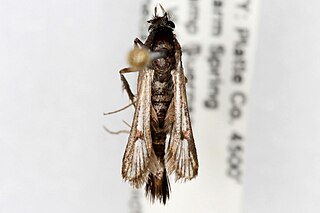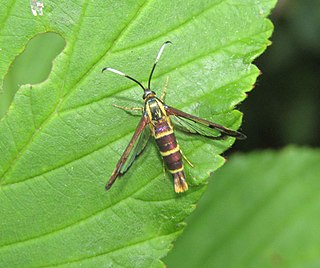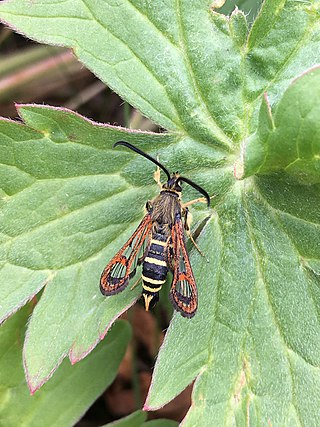
The Sesiidae or clearwing moths are a diurnal moth family in the order Lepidoptera known for their Batesian mimicry in both appearance and behaviour of various Hymenoptera.

Carmenta is a genus of moths in the family Sesiidae.
Carmenta anthracipennis, the liatris borer moth, is a moth of the family Sesiidae. It was described by Jean Baptiste Boisduval in 1875, and is known from the United States, including Florida, Texas, Massachusetts and Illinois.
Carmenta arizonae is a moth of the family Sesiidae. It was described by William Beutenmüller in 1898. It is known from the US state of Arizona.
Carmenta armasata is a moth of the family Sesiidae. It was described by Herbert Druce in 1892. It is known from the US state of Texas.
Carmenta auritincta, the Arizona clearwing moth, is a moth of the family Sesiidae. It was described by Engelhardt in 1925. It is known from south-eastern Arizona and northern Mexico.

Carmenta bassiformis, the eupatorium borer moth or ironweed clearwing moth, is a moth of the family Sesiidae. It was described by Francis Walker in 1856, and is found in the United States from Massachusetts to Florida, west to Wisconsin, Kansas and Texas.

Carmenta giliae is a moth of the family Sesiidae. It was described by Henry Edwards in 1881, and is found from western Alberta to north-western British Columbia, south to Arizona and New Mexico. The habitat consists of mid-to-high elevation montane meadows.

Carmenta ithacae is a moth of the family Sesiidae. It was described by William Beutenmüller in 1897. It is known from North America, including Florida, Arizona, Illinois, Michigan, Nebraska, New York, Virginia and Wisconsin.
Carmenta prosopis is a moth of the family Sesiidae. It was described by Henry Edwards in 1882, and is known from northern Mexico, and south-western United States.

Carmenta pyralidiformis, the boneset borer, is a moth of the family Sesiidae. It was described by Francis Walker in 1856. It is known from the United States, including Arkansas, Illinois, Maryland, Massachusetts, Michigan, Missouri, New Jersey, Ohio and Virginia.
Carmenta querci is a moth of the family Sesiidae. It was described by Henry Edwards in 1882, and is known from the United States, including Colorado and Arizona.
Carmenta subaerea is a moth of the family Sesiidae. It was described by Henry Edwards in 1883 and is known from the US state of Arizona.
Carmenta tecta, the mistletoe stem borer, is a moth of the family Sesiidae. It was described by Henry Edwards in 1882. It is known from the United States, including Arizona.
Carmenta texana, the Texana clearwing moth, is a moth of the family Sesiidae. It was described by Henry Edwards in 1881 and is known from the US states of Texas and Florida.

Carmenta verecunda is a moth of the family Sesiidae. It was described by Henry Edwards in 1881, and is known from the United States, including Colorado, Utah, California and Arizona.
Carmenta wellerae is a moth of the family Sesiidae. It was described by W. Donald Duckworth and Thomas Drake Eichlin in 1976. It is known from southern Arizona in the US and northern Mexico. The habitat consists of mountains and foothills.
Carmenta surinamensis is a moth of the family Sesiidae. It was described by Heinrich Benno Möschler in 1878, and is known from Brazil, Suriname, Guyana, Trinidad, Panama and Costa Rica. The larvae of the species have been found on seeds of the plant Prioria copaifera, Pentaclethra macroloba, and plants in the genus Mora.
Carmenta laurelae is a moth of the family Sesiidae. It was described by Larry N. Brown, Thomas D. Eichlin and J. Wendell Snow in 1985, and is known from the US state of Florida.





